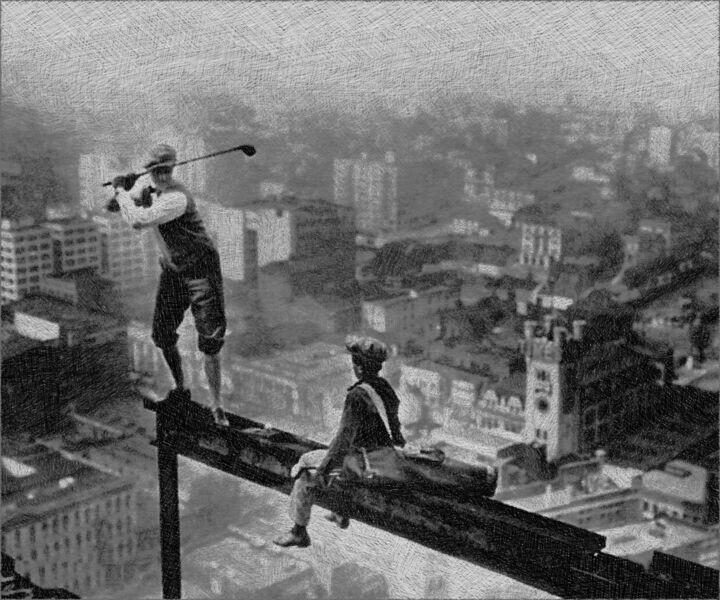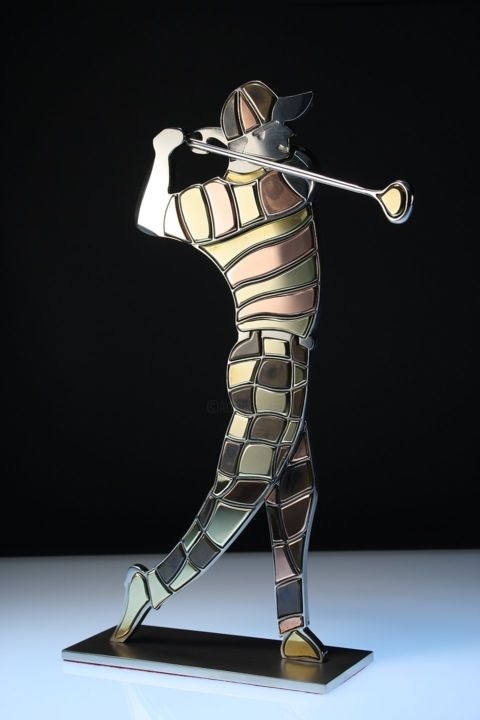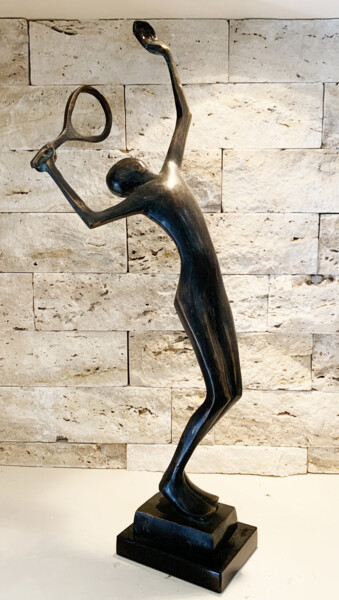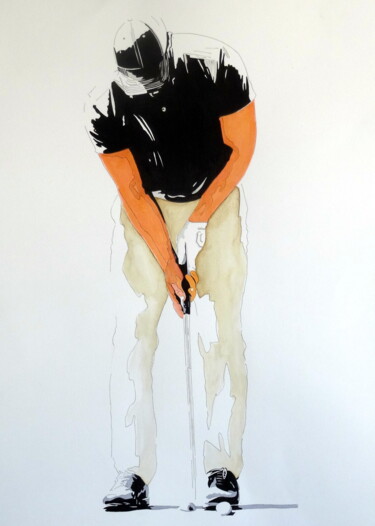 Thibaud Dière, The golfer, 2016. Sculpture, bronze on metal, 30 x 11 x 6 cm / 4.00 kg.
Thibaud Dière, The golfer, 2016. Sculpture, bronze on metal, 30 x 11 x 6 cm / 4.00 kg.
Brief history of golf
"To discover a man's true character, play golf with him."
The words of Pelham Grenville Wodehouse, one of the best-known English writers and humorists of the 20th century, introduce the history of one of the world's oldest and most popular games, golf. In fact, its origins date back to the 15th century, when it was first played on the east coast of Scotland, in an area near the royal capital of Edinburgh. In this context, players tried to hit a pebble on the sand dunes around paths, using a bent stick or club. The great enthusiasm felt for the sport, however, led many Scots to neglect even military training, so much so that parliament had to ban this "dispersive" discipline in 1457. Although the population largely ignored this ban, it was not until 1502 that the game received the royal seal of approval, which was when King James IV of Scotland became the world's first golfing monarch. From this point on, the popularity of golf spread rapidly throughout 16th-century Europe, although it did not officially become a sport until the Gentlemen Golfers of Leith formed the first club in 1744, establishing an annual competition with silverware prizes. Instead, the first 18-hole course was built in St Andrews (Scotland), specifically in 1764, establishing the now-recognized standard of the game. During the 19th century, as the power of the British Empire expanded beyond the borders of Europe, golf became a world sport, in fact: the first golf club founded outside Scotland was Royal Blackheath (near London) in 1766, while the first golf club outside Britain was Bangalore, India (1820).
 Kristof Toth, Golfer, 2017. Sculpture, bronze / stone on stone, 20 x 35 x 8 cm / 2.00 kg.
Kristof Toth, Golfer, 2017. Sculpture, bronze / stone on stone, 20 x 35 x 8 cm / 2.00 kg.
 Ingrid Dohm, Aldeen golf course, 2011. Oil painting, 76.2 x 101.6 cm.
Ingrid Dohm, Aldeen golf course, 2011. Oil painting, 76.2 x 101.6 cm.
Masterpieces of art that tell the story of Golf
Many masterpieces that fall outside the main themes of the fine arts, such as, for example, that of landscape, portrait, genre scenes, etc., are often unknown. What has been said emerges forcefully in regard to the works that, although created by the greatest masters in history, immortalized the elite world of golf. Indeed, among the many masterpieces depicting the sport, it is highly recommended to take note of: Winter Landscape by Hendrick Avercamp (ca. 1630), Bobby Jones by Wayman Adams (1926), The Golfers by Charles Lees (1847), Series of 16 photographs by Harold Edgerton (1935), The Golf Course, North Berwick, by Sir John Lavery (c.1920) and The Golf-Player by Rembrandt (1654).  Rembrandt, The Golf-Player, 1654. Etching on paper, 9.50 x 14.30 cm. Edinburgh: Scottish National Gallery Of Modern Art.
Rembrandt, The Golf-Player, 1654. Etching on paper, 9.50 x 14.30 cm. Edinburgh: Scottish National Gallery Of Modern Art.
Harold Edgerton, Series of 16 photographs, 1935. Gelatin silver prints. Far Hills: United States Golf Association Museum
About the latter master's etching on paper, preserved at the Scottish National Gallery Of Modern Art, it depicts the Dutch game of "kolf," which has many similarities with Scottish golf. Indeed, in kolf there is that same intent to hit a small ball in order to reach a target several hundred yards away. Nevertheless, the Dutch sport lacks the hole, a fundamental peculiarity that has allowed Scottish golf to be recognized as the main ancestor of today's sport. Returning to Rembrandt's work, it is divided into three scenes juxtaposed with each other, in fact: in the foreground we find a young man absorbed in his thoughts, in the background to the left a kolf player and, further to the right, two men intent on dialogue. Regarding the technique of execution, only the reflective character has been well-defined by modeling lines, as the other three turn out to have been done through the use of simple outline hatching. As for Harold Edgerton, on the other hand, this genius of twentieth-century photography succeeded in breaking down, and stopping in time, the game of golf within sixteen shots, having as their subject the well-known golfer Robert Tyre "Bobby" Jones, Jr. Precisely the photographic investigation of the American artist, as can be seen from the aforementioned photographic series, has often aimed at capturing and defining phenomena impossible to see with the naked eye.
 Recyclage Design - Réanimateur D'Objets, Bronze Golfer, 2020. Sculpture, bronze on metal. 45 x 200 x 12 cm / 4.00 kg.
Recyclage Design - Réanimateur D'Objets, Bronze Golfer, 2020. Sculpture, bronze on metal. 45 x 200 x 12 cm / 4.00 kg.
 Charles Jiao, Golf course trail, 2020. Oil on canvas, 45,7 x 61 cm.
Charles Jiao, Golf course trail, 2020. Oil on canvas, 45,7 x 61 cm.
Artmajeur's artworks about golf
There are many works of art by Artmajeur that, among paintings, mosaics, sculptures, drawings, watercolors, and pastels, immortalize the world of golf, highlighting its players, techniques, and courses, often immortalized through a keen taste for the details and peculiarities of this sport. Within such rich figurative research there is no shortage of references to the highest historical artistic tradition, both in terms of subjects and techniques, just as the works show us: The golfer by Jean D'Hau, Golfer on girder over New York by Tony Rubino and Golf game 1 by Peter Vamosi.
 Jean D'Hau, The golfer, 2017. Bronze sculpture, 65 x 23 x 15 cm / 4.00 kg.
Jean D'Hau, The golfer, 2017. Bronze sculpture, 65 x 23 x 15 cm / 4.00 kg.
Jean D'Hau: The golfer
The sculptural work of the eclectic French artist Jean D'Hau, is part of a figurative research that is probably the result of a contemporary reinterpretation and revisiting of Alberto Giacometti's typical stylistic features. In fact, The golfer is distinguished by its slender and threadlike, fragile and linear forms, created through the use of a poor and essential material, such as bronze. In addition, the surface of the sculpture has "grooves" and irregularities, running through it from head to toe, firmly anchored to the base. In reality, however, Jean D'Hau's work seems to have freed itself from the torment that plagued Giacometti's sculptures, indelibly marked by fears and anxieties, a mirror of human frailty and imperfection. In conclusion, The golfer re-proposes stylistic features akin to the work of a great master of the past, while freeing them from the burden of suffering, thanks in part to its treatment of the lighthearted theme of golf.
 Tony Rubino, Golfer on girder over New York drawing, 2022. Painting, acrylic / lithograph on canvas, 38.1 x 45.7 cm.
Tony Rubino, Golfer on girder over New York drawing, 2022. Painting, acrylic / lithograph on canvas, 38.1 x 45.7 cm.
Tony Rubino: Golfer on girder over New York drawing
Tony Rubino's artwork, created in a mixed technique involving acrylic painting and etching, repurposes, enriching it with characteristic lithographic marks, the famous photograph taken by Charles C. Ebbets, the iconic Rockefeller Center artist best known for the popular Lunch atop a skyscraper. Accordingly, Tony Rubino has "manipulated" a "must" in the history of photography, within which the game of golf appears in a completely unprecedented, surreal and highly dangerous context. Nevertheless, the veracity of the historic shot cannot be doubted, as the photograph in question, some ninety years old, certainly cannot have been retouched with modern technology. As a result, the photograph freezes forever, both a "borderline" situation and the carefree recklessness of one of the most reckless and talented photographers in the United States, to whom Tony Rubino pays tribute with this sympathetic "remake."
 Peter Vamosi, Golf game 1, 2021. Acrylic on canvas, 40 x 40 cm.
Peter Vamosi, Golf game 1, 2021. Acrylic on canvas, 40 x 40 cm.
Peter Vamosi: Golf game 1
The painting by Slovak artist Peter Vamosi tells us about a fantastic story that, immersed in a parallel world, involves two cheerful and carefree golfers, observed by a figure in the background in a kind of "adoration." Precisely, the purpose of Vamosi's artistic production is to give life to mythical realities, full of harmony, love, tranquility, empathy and optimism, feelings rare in modern conflict. Speaking of style, the work represents a kind of summary of Western art history, as we can find references to Fauvism, Surrealism, Metaphysics, Cubism and Christian art in it. In fact, the eccentric colors in Golf game 1 can be traced back to Fauvism, while the fragmented bodies hint at a surreal atmosphere. In addition, the characters are reminiscent, albeit very distantly, of Giorgio de Chirico's metaphysical mannequins, which were, however, realized through sectional painting close to cubism. Finally, the figure in the background could be a contemporary, secular interpretation of the prayer-giver: a figure, male or female, usually in frontal view, with arms raised to about shoulder height, in a gesture that must surely be interpreted as a manifestation of prayer typical of Christian art. In conclusion, all these references to the figurative tradition of the past make us understand how it always continues to live on, within contemporary artworks characterized by even very personal points of view and styles.


 Olimpia Gaia Martinelli
Olimpia Gaia Martinelli























